Alfa Romeo 159Debut: 2005Maker: Alfa Romeo Predecessor: 156 |
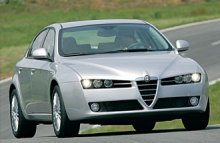 From
1997 to 2005, Alfa built 680,000 units of 156. That may account for
only 1 and a half year of BMW 3-series production, but it meant a lot
to Alfa Romeo. The 156 not only won European Car of the Year Award in
1998, but it also used its beauty and charismatic character to bring
Alfa Romeo back to the forefront of premium car industry. Undoubtedly,
car enthusiasts will remember its stylish design, the lovely twin-spark
16V engine (which was replaced by the equally impressive JTS direct
injection engine in later years), the sonorous V6 in the GTA model, the
Selespeed gearbox (which was the first production automated manual
gearbox in the world)... From
1997 to 2005, Alfa built 680,000 units of 156. That may account for
only 1 and a half year of BMW 3-series production, but it meant a lot
to Alfa Romeo. The 156 not only won European Car of the Year Award in
1998, but it also used its beauty and charismatic character to bring
Alfa Romeo back to the forefront of premium car industry. Undoubtedly,
car enthusiasts will remember its stylish design, the lovely twin-spark
16V engine (which was replaced by the equally impressive JTS direct
injection engine in later years), the sonorous V6 in the GTA model, the
Selespeed gearbox (which was the first production automated manual
gearbox in the world)... Being a fan of Alfa, I sincerely hope Alfa 159, the successor to 156, can lift the game and beat BMW 3-Series. But since 3 years ago we started hearing some bad news leaking from Italy. First of all, Alfa design boss Walter de Silva - the man who shaped 156 - left the company and joined Seat / Audi. Then Alfa announced the new 159 would be built on a new platform co-developed with Saab (as GM bought 20% of Fiat group). This could kill the unique character of Alfa. Later, things got worse when I heard the car would replace all the fabulous Alfa engines with GM's 4-cylinders and a Holden V6. Oh my God ! do these mean the end of a great era ? 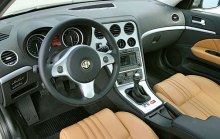 Fortunately,
my worry was found unproved. Alfa Romeo took appropriate measures to
make sure the 159 preserves its unique character. It even scrapped the
unimpressive in-house design at the last minute and adopted a proposal
from Giorgetto Giugiaro. That Italian design master has been off form
for some time, but this time he refocused his energy and helped Alfa to
create the most beautiful car in the class ! from the rear, 159 looks
very much like its predecessor. But elsewhere the car is sleeker and
sharper. Its nose is especially a masterpiece - the narrow headlamp
clusters with 3 small round lamps each side draw your attention towards
the shield grille. This feature was first introduced in Giugiaro's Alfa
Brera concept car, and it is also what attracted Alfa to employ
Giugiaro to design the production Brera and 159. Fortunately,
my worry was found unproved. Alfa Romeo took appropriate measures to
make sure the 159 preserves its unique character. It even scrapped the
unimpressive in-house design at the last minute and adopted a proposal
from Giorgetto Giugiaro. That Italian design master has been off form
for some time, but this time he refocused his energy and helped Alfa to
create the most beautiful car in the class ! from the rear, 159 looks
very much like its predecessor. But elsewhere the car is sleeker and
sharper. Its nose is especially a masterpiece - the narrow headlamp
clusters with 3 small round lamps each side draw your attention towards
the shield grille. This feature was first introduced in Giugiaro's Alfa
Brera concept car, and it is also what attracted Alfa to employ
Giugiaro to design the production Brera and 159.Compare with the new Chris Bangle BMW 3-Series, one term describe them the best - "Beauty and the Beast". The 159 is not only far more handsome outside, but also beats BMW inside. This cabin truly reflects the best tradition of Alfa. It has very sporty and driver-focused dashboard / console to inspire its drivers. Ditto the great-looking leather seats and the aluminum trim. In contrast to 156, materials and build quality now matches the new 3-Series, while the driving position is finally set right, no Italian long-arm / short-leg anymore. Space-wise, the 159 is a little more roomy than the 3er, including rear headroom and legroom. However, a bread-and-butter Ford Mondeo will beat both cars in shear space. Chassis  The
so-called "Premium
platform" was originally a joint development between Alfa and Saab, but
in the mid-way of development Saab pulled out because it thought the
platform too expensive for its declining image – a thing unsurprising
if you see the Chevrolet Trailblazer-based Saab 9-7X. As a result, Alfa
finished the remaining work by its own. Maybe that is why the 159 can
preserve its own character. The
so-called "Premium
platform" was originally a joint development between Alfa and Saab, but
in the mid-way of development Saab pulled out because it thought the
platform too expensive for its declining image – a thing unsurprising
if you see the Chevrolet Trailblazer-based Saab 9-7X. As a result, Alfa
finished the remaining work by its own. Maybe that is why the 159 can
preserve its own character. The new platform employs very sophisticated layout. To deal with torque steer problem, it adopts 4-wheel-drive for the most powerful engine (while less powerful models are front-wheel-drive). The Q4 system uses a Torsen C center differential to distribute 57% power to the rear wheels under normal driving, hence delivering a slightly rear-biased character that a pure driver's car needed. This is obviously better than the 50:50 Torsen differential employed by Audi's standard Quattro system (although the new RS4 employs another system). 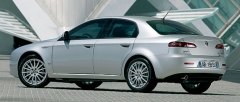 The
suspensions are also very sophisticated. Like the outgoing 156, the
front suspension is double-wishbones design, but now with aluminum
wishbones, enhanced geometry (the wishbones are located far apart) and
a more rigid subframe for mounting the suspension. At the rear, the
156's strut-type suspension has been replaced with a far more
sophisticated 4-link design. As a result, it is more resistant to
lateral movement while being elastic to vertical movement. In other
words, tighter body control and better ride comfort simultaneously. The
suspensions are also very sophisticated. Like the outgoing 156, the
front suspension is double-wishbones design, but now with aluminum
wishbones, enhanced geometry (the wishbones are located far apart) and
a more rigid subframe for mounting the suspension. At the rear, the
156's strut-type suspension has been replaced with a far more
sophisticated 4-link design. As a result, it is more resistant to
lateral movement while being elastic to vertical movement. In other
words, tighter body control and better ride comfort simultaneously.The chassis itself is also state of the art. Having a torsional rigidity at 31,400 Nm / degree, it exceeds Saab 9-3 by an astonishing 57% ! this is achieved by using multi-ply sheet metal, extensive laser welding and boxed element structure. The rigid chassis benefits crash protection, NVH suppression as well as handling. Alfa-like Engines In the past 26 years, Alfa Romeo's V6 has been renowned for power, willingness and sound quality, especially the latter. However, after so many years the old architecture has run out of potential thus Alfa decided to replace it with GM's global V6. This engine was developed and manufactured by Holden in Australia and has been widely used in various Holdens, Cadillac CTS, Buick LaCrosse, Saab 9-3, Opel Vectra OPC etc. Alfa 159 chose the 3.2-litre version, completed with dual continuous VVT – a significant advance over the old V6. 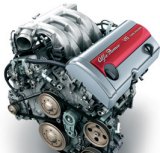 However,
that's only the basis. In order to make sure it produce the right “Alfa
noise”, Alfa adds its own cylinder heads and intake manifolds in Italy.
The engine note is tuned to replicate the traditional Alfa V6, yes,
that musical, addictive growl ! Alfa also added its unique JTS direct
injection system to the engine, enabling a 11.3:1 compression ratio to
enhance power. The result is 260 horsepower – even higher than the
3.6-litre version of the Holden engine – and a maximum rev of 7200 rpm.
On the other hand, the VVT enables a very wide power band - from 1800
to 6250 rpm there is at least 90% of the maximum torque (237 lbft)
available. However,
that's only the basis. In order to make sure it produce the right “Alfa
noise”, Alfa adds its own cylinder heads and intake manifolds in Italy.
The engine note is tuned to replicate the traditional Alfa V6, yes,
that musical, addictive growl ! Alfa also added its unique JTS direct
injection system to the engine, enabling a 11.3:1 compression ratio to
enhance power. The result is 260 horsepower – even higher than the
3.6-litre version of the Holden engine – and a maximum rev of 7200 rpm.
On the other hand, the VVT enables a very wide power band - from 1800
to 6250 rpm there is at least 90% of the maximum torque (237 lbft)
available.The same story goes for the inline-4 engines. Alfa replaced its 1.6 twin-spark and 2.0 JTS engine with a couple of new engines based on GM's L850 engine (see various Opel). The L850 has all alloy construction thus is 20% lighter than the outgoing engines. Its dual continuous variable valve timing is also much more advanced than the outgoing two-step, intake side only VVT, ensuring at least 88% maximum torque available from 2000 rpm. Like the old engines, it has twin balancer shafts to eliminate vibration normally associated with inline-4 engines. Again, Alfa added its own cylinder head and intake manifolds to produce a lovely engine note. JTS direct injection raises compression ratio to 11.3:1. The 1.9-litre version produces 160 hp and 140 lbft of torque, compare with the old 1.6 twin-spark's 120 hp / 107 lbft. The 2.2-litre version produces 185 hp and 170 lbft, up from the old 2.0 JTS' 165 hp / 152 lbft. These offset the 200 kg weight gain the 159 got. In the diesel side, Alfa shares engines with the whole Fiat group – the leader of diesel engines in the industry. Basically, its Multijet technology is still the best for refinement and consumption. Now also with the highest specific power in the class. The new 2.4 JTDM 5-cylinder 20V engine produces 200hp and 295 lbft. 1.9 JTDM 16V produces 150hp and 236 lbft. 1.9 JTDM 10V produces 120hp and 206 lbft. All of them employs VTG turbocharger and particle filter. Although these diesel engines are excellent, especially the powerful 2.4 JTDM, they are not the best companion to the 159, because the petrol engines are even better. If you share my believe that a true Alfa engine should love to rev and sing, then the choice should be the petrol engines. Among them, the 2.2 JTS is perhaps the best of the best, followed closely by the 3.2 V6 and 1.9 JTS. On the Road Facing the beautiful dashboard, wrapping with the beautiful leather seats, hearing the melodious engine note, if there is any driving environment more delightful than BMWs, this is it. The cabin is surprisingly quiet and refined. There must be a lot of sound-deadening materials employed, and the chassis is remarkably solid. The V6 and the four-cylinder JTS engines are silky smooth at any rev. The diesels are inevitably rougher, but compare with other diesel engines they are still very refined, especially the 5-cylinder 2.4. 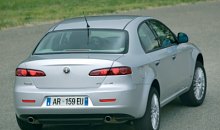 The suspensions are much more
absorbent than 156. The ride is firm but compliant on bumpy roads. The suspensions are much more
absorbent than 156. The ride is firm but compliant on bumpy roads. All versions of 159 handle brilliantly, with tight body control, good grip and responsive steering. In terms of pure talent, the 4WD-equipped V6 is the best of all, thanks to the additional grip and neutral character at the limit. However, the 2.2 JTS is benefited by a 250 kg lighter body and a lighter nose, thus it feels better balanced and more nimble. Unquestionably, this is the best handling front-wheel-drive sedan in the world ! The question is, can it beat the rear-drive BMW 3-Series ? Not yet. Despite of the great effort of Alfa, the BMW is even better balanced, more neutral, more agile and more feelsome at the steering wheel. In almost every aspect, the new BMW 3-Series edges out the Alfa 159, no matter the 2.2 JTS or the 4WD V6. Its more compact body, lighter weight, 50:50 balance, lower polar moment of inertia and rear-wheel drive play important roles there. That said, Alfa 159 is simultaneously a good driver's car and a comfortable executive car. It might lacks the ultimate talent of BMW 3-Series, but its beautiful styling, beautiful cabin and beautiful sound can lure a lot of buyers from the BMW camp. The only worry is reliability and servicing – a traditional weakness of Alfa Romeo. There are signs that Alfa worked hard to improve this area, but only time will tell. |
| The above report was last updated on 21 Aug 2005. All Rights Reserved. |
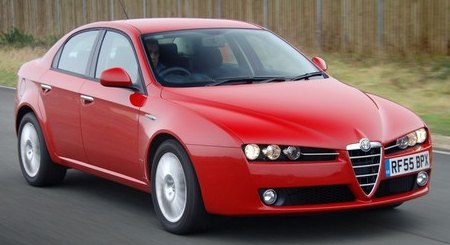

 159 2.0JTDM
159 2.0JTDM Hide all
Hide all
